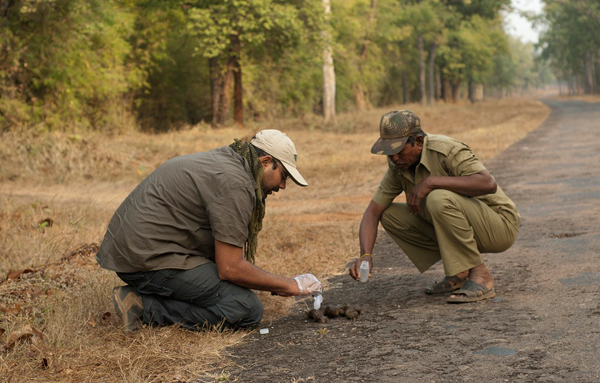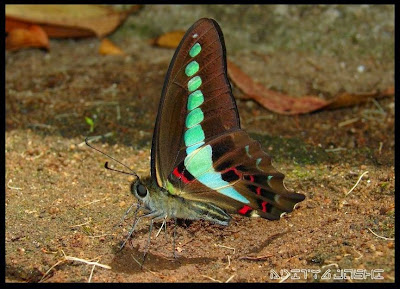Our team has successfully rehabilitated Indian pangolins in the wild. This is the first-ever case of successful rehabilitation effort of this species where the released individuals are monitored in the wild using telemetry. In anti-poaching operations where pangolin scales are recovered, those animals are already dead. Where live pangolins are involved, globally there is about 50 % death-rate among released pangolins. Given that several pangolins are rescued in the central Indian landscape, this new initiative by Madhya Pradesh Forest Department and WCT is to ensure better survival rates of these released individuals in the wild and thus have a positive impact on the population of this endangered species
vidarbha wildlife - aditya joshi
Saturday, February 15, 2020
World’s first radio-tagged Indian Pangolin (Manis crassicaudata)
Our team has successfully rehabilitated Indian pangolins in the wild. This is the first-ever case of successful rehabilitation effort of this species where the released individuals are monitored in the wild using telemetry. In anti-poaching operations where pangolin scales are recovered, those animals are already dead. Where live pangolins are involved, globally there is about 50 % death-rate among released pangolins. Given that several pangolins are rescued in the central Indian landscape, this new initiative by Madhya Pradesh Forest Department and WCT is to ensure better survival rates of these released individuals in the wild and thus have a positive impact on the population of this endangered species
Thursday, April 19, 2018
‘Lalgarh tiger’ had a right to live
Tiger that had ‘strayed’ into a fragmented forest found killed
Dubbed as the ‘Lalgarh tiger’ in media reports, the adult male aged between 10 and 12 years, was allegedly killed by a hunting group with spears and arrows during an ongoing ‘shikar’ (hunting) season in April, according to the state forest department. Initial analysis has revealed skull fractures.
Binay Krishna Barman, forest minister of West Bengal, promised strict action against the perpetrators. “We issued orders to capture the tiger and relocate it as it had strayed into fragmented forest patches that harbour a considerable number of human settlements.
Foresters said the big cat never killed a human.
“The tiger was at risk because it was present in a landscape where it was not seen before. We will continue with our sensitisation programme among the tribals,” said Sinha
Wildlife biologist Milind Pariwakam slammed the portrayal of the tiger as a “stray.” Noting tiger movements or dispersals are routine activities and have always been going on, Pariwakam said such dispersing individuals are good for the population as a whole as they bring much needed genetic viability to the population and can re-colonise areas from which tigers went locally extinct.
“Further, trying to capture a dispersing individual merely because it has been seen in an area is a violation of the law. The Wildlife (Protection) Act under Section 11, allows the capture of an individual only if it ‘has become dangerous to human life’. The Lalgarh tiger was in no way ‘dangerous to human beings’ and thus, its attempted capture was itself a violation of the protection given to wildlife under the law,” Pariwakam highlighted.
“Today, most wild tigers live in small, isolated protected areas within human-dominated landscapes in the Indian subcontinent. These protected areas are too small to even hold demographically viable populations. The future survival of tigers depends on increasing local population size, as well as maintaining connectivity between populations,” said WCT researcher, Aditya Joshi.
https://india.mongabay.com/2018/04/19/tiger-that-had-strayed-into-a-fragmented-forest-found-killed/
Monday, January 1, 2018
Maintaining tiger connectivity and minimizing extinction into the next century: Insights from landscape genetics and spatially-explicit simulations
We used landscape genetic simulations to model 86 different scenarios that incorporated impacts of future land-use change on inferred tiger-population connectivity and extinction.
Key findings and conservation implications:
- Dense human settlements and roads with high traffic are detrimental to tiger movement.
- Unplanned expansion of National Highways without mitigation measures significantly increases probability of extinction in many Protected Areas (for dispersal threshold of 500 km and 300 km)
- Protecting corridors, stepping-stone populations and increasing numbers would be critical for tiger survival into the next decade
- Our results highlight the immediate need for regional land-use management and planning exercises aimed at managing tiger populations as a network of PAs connected with corridors.
- Our simulations provide a means to quantitatively evaluate the effects of different land-use change scenarios on connectivity and extinction, linking basic science to land-use change policy and planned infrastructure development.
Sunday, January 29, 2017
Photographic Records of Eurasian Otter Lutra lutra from the Central Indian Landscape
Our photographic record of Eurasian otters from the Satpura Tiger Reserve extends the known geographical range of the Eurasian otter to the central Indian landscape and also provides the first photographic evidence of the species from India till date.
Thursday, June 12, 2014
Will tigers march ahead?
Friday, September 16, 2011
Fan-throated lizard - hunting
Wednesday, September 14, 2011
Wild dogs (Dholes) marking their territory
River Lapwing (Vanellus duvaucelii) at Bor dam
Sunday, May 1, 2011
Oriental Pratincole (Glareola maldivarum)

Wednesday, April 27, 2011
Oriental Wolf Snake (Lycodon capucinus)
 Oriental Wolf Snake (Lycodon capucinus)
Oriental Wolf Snake (Lycodon capucinus) Juvenile - Oriental Wolf Snake (Lycodon capucinus)
Juvenile - Oriental Wolf Snake (Lycodon capucinus)Saturday, January 1, 2011
Wild Dogs @ Bori Satpuda
Saturday, July 31, 2010
Tiger from BOR Wildlife Sanctuary (Maharashtra)


Sunday, July 18, 2010
Greater Painted Snipe (Rostratula benghalensis) Female
Saturday, July 17, 2010
Jungle Bush Quail (Perdicula asiatica)
Wednesday, July 14, 2010
Clown Bug !
Nilgai (Boselaphus tragocamelus)
Wednesday, May 19, 2010
Awaiting Death !
Awaiting Death - Vultures are scavengers, and their life depends on a death. Today, it seems like they are awaiting their own demise. Can we stem the tide?
Moved by the plight of the vultures in Ramnagaram, we decided to make a short documentary that showcases various aspects of the problem. We thought that the reason vultures numbers were decreasing could have been due to changing cattle practices, illegal sale of cattle diclofenac and loss of habitat due to quarrying. We spoke to local villagers about the cattle practices followed in their villages. What follows is a story of one of the last few breeding populations of vultures in southern India. We hope that immediate steps are taken to save this landscape and its inhabitants.
Saturday, February 13, 2010
Changeable Hawk-Eagle enjoying a feast !
While looking for Tiger scats on a trail in Bor wildlife sanctuary, came across a carcass of a calf of Nilgai. I looked at it and moved ahead. On the way back saw a Changeable Hawk-Eagle on the carcass. For the next 3 days this eagle had a feast! I couldn't make out who made the kill, but it was clear that the Hawk-eagle was enjoying it. As my routes were fixed, I got to see it daily, and the eagle didn't bother at all; it was busy with it's ....food for life. It was a nice opportunity to observe this amazing raptor at close quarters.
Sunday, December 6, 2009
Bharal the "Blue Sheep"
.JPG)
Bharal the "Blue Sheep" from Sikkim. On the way to Gurudongmar Lake from Lachen, at around 5000 mt above the sea level; saw these animals. They merge with the background excellently and thus are hard to see; but some males were fighting and that's why we could spot them. Females were nicely enjoying the warmth of sun, but males had something else on their mind.
Tuesday, November 10, 2009
Hodgson's flying squirrel (Petaurista magnificus)
 A really rare image. Hodgson's flying squirrel (Petaurista magnificus). On the way back to Gangtok from Lachen (Sikkim) at around 9.30 PM, saw something like a flying squirrel on the edge of the road. First we thought it is injured, but when looked through the binocs it was clear that its a flying squirrel and is not injured but is licking the ground.
A really rare image. Hodgson's flying squirrel (Petaurista magnificus). On the way back to Gangtok from Lachen (Sikkim) at around 9.30 PM, saw something like a flying squirrel on the edge of the road. First we thought it is injured, but when looked through the binocs it was clear that its a flying squirrel and is not injured but is licking the ground. It was there for about 3 minutes. Then it went to the other side of the road, facing the valley..... got ready to glide.........then................vanished in the dark.
It was there for about 3 minutes. Then it went to the other side of the road, facing the valley..... got ready to glide.........then................vanished in the dark.The main identification character is the reddish-orange tail with black tip. This was an amazing sighting of this elusive animal.
Sunday, October 18, 2009
Saturday, October 17, 2009
Ant-Mimic Spider (Myrmarachne plataleoides)
This spider mimics the weaver ants.
Tuesday, April 28, 2009
Thursday, March 26, 2009
Hermit crabs from South Andamans
 These guys utilize shells of snails to protect their soft abdomen from predators. Not only abdomen but whole body is retracted inside the shell.
These guys utilize shells of snails to protect their soft abdomen from predators. Not only abdomen but whole body is retracted inside the shell.
Sarus Cranes !

Sarus Cranes from Navegaon NP. The one with a Brownish orange head is a Sub-adult. These are amazing birds, but the habitat in which they live is heavily modified, even the eggs are stolen as they are believed to have some So called "Medicinal properties". The future of these cranes is really uncertain in this area.
Friday, January 9, 2009
Bar-headed Geese

Collared Bar-headed goose photographed near

One of these collared Bar-headed goose came near Nagpur, Maharashtra (First Photograph).Due to this photograph of collared Bar-headed goose, the migration of these birds was revealed.

These birds come every winter season near
Stream Glory (Neurobasis chinensis) - a Damselfly
 Stream Glory - Female. These are really wonderfull. Females of this species are with brownish- semi-transparent wings. The body is greenish metallic in colour. But the males are just Superb.
Stream Glory - Female. These are really wonderfull. Females of this species are with brownish- semi-transparent wings. The body is greenish metallic in colour. But the males are just Superb.Sunday, November 2, 2008
Indian Vulture........ Soaring.......
 `~ Gyps indicus ...followed by a Black Kite.....~'
`~ Gyps indicus ...followed by a Black Kite.....~'

But the best part was looking at these beauties soaring right above us while we were resting on top of a hillock.
Saturday, October 18, 2008
Elliot's forest lizard (Calotes ellioti)
Thursday, October 16, 2008
Grey Francolins roosting (Francolinus pondicerianus)
 Grey Francolins roosting (Francolinus pondicerianus)
Grey Francolins roosting (Francolinus pondicerianus)When i started birdwatching, I use to wonder whether these birds can ever sit on a tree like most of the others do? Although I got the answer but never saw them roosting. Early morning in State Forestry College campus , Coimbatore, we went for searching Slender Loris with AJT Johnsing Sir and came across this roosintg group. It was a superb experience.
Wednesday, October 15, 2008
Short - nosed fruit bat
Bengal Monitor (Varanus bengalensis)

Bengal Monitor (Varanus bengalensis)
The Formadible Lizard. There are stories which say people use to climb forts using Monitors !!!! But these lizards have really very powerfull claws. Their diet consists of small mammals, lizards, snakes, birds, eggs, etc.
Sad part is that they are hunted for meat and as most of the other wildlife, for "medicinal properties".










-+Adult+male.JPG)

















